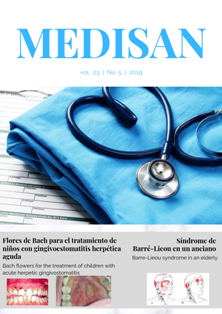Modifications of the posterior bony space for third molars from childhood to adolescence
Keywords:
child, adolescent, third molar, posterior bony space, retromolar space, orthodontics.Abstract
Introduction: The correct disposition of teeth depends in great measure on the growth of maxillary, especially the third molars that are the last ones in eruption.
Objective: To estimate the changes in the posterior bony space according to age and its relationship with epidemic variables.
Methods: An observational, descriptive and cross-sectional study was carried out in children belonging to José Martí Pérez Teaching Polyclinic in Santiago de Cuba, from May, 2016 to February, 2017, for which panoramic X-rays were used in the measures, analyzed according to age, sex and color of the skin.
Results: It was remarkable that the difference of the posterior bony space from childhood to adolescence was 9 mm for 18 molar, of 8.1 for 28 molar, of 12.5 for 38 molar and of 11.5 for 48 molar; significant differences were not observed between sex and color of the skin.
Conclusions: With the evaluation of the dimensional magnitude of this space it is possible to predict the growth of the maxillary to give location to the third molars during the course from the childhood to the adolescence.
Downloads
References
2. Batista Camargo I, Batista Sobrinho J, Sávio de Souza Andrade E, Van Sickels JE. Correlational study of impacted and non-functional lower third molar position with occurrence of pathologies. Prog Orthod. 2016 [citado 01/02/2017];17:26. Disponible en: https://www.ncbi.nlm.nih.gov/pmc/articles/PMC5011069/pdf/40510_2016_Article_139.pdf
3. Rivero Pérez O. Dientes retenidos. En: Cirugía bucal. Selección de temas. La Habana: Editorial Ciencias Médicas; 2018. p. 233-42
.
4. Céspedes Isasi R, Díez Betancourt J, Carbonell Camacho O, González Piquero G. Terceros molares: diagnóstico ortodóntico. Rev Cubana Ortod. 2000 [citado 22/09/2017];15(1):39-43. Disponible en: http://bvs.sld.cu/revistas/ord/vol15_1_00/ord04100.pdf
5. Fernández Pérez E, De Armas Gallegos LI, Batista González NM, Llanes Rodríguez M, Ferreiro Marín A. Análisis del espacio disponible para la erupción de los terceros molares mandibulares en radiografías panorámicas. Actas del Congreso Internacional Estomatología 2015; 2-6 Nov 2015; La Habana, Cuba. La Habana: Universidad de Ciencias Médicas; 2015 [citado 22/09/2017]. Disponible en: http://www.estomatologia2015.sld.cu/index.php/estomatologia/nov2015/paper/view/210/103
6. Pérez Cabrera DL, Alcolea Rodríguez JR, Velázquez Zamora RM, León Argoneses Z. Terceros molares. Mediciones cefalométricas del espacio disponible para su posible erupción. MULTIMED. 2012 [citado 27/6/2018];16(4). Disponible en: http://www.revmultimed.sld.cu/index.php/mtm/article/view/594/947
7. De Tobel J, Radesh P, Vandermeulen D, Thevissen PW. Anautomated technique tost age lower third molar development on panoramic radiographs for age estimation: a pilot study. J Forensic Odontostomatol. 2017 [citado 01/02/2018];35(2):42-54. Disponible en: https://www.ncbi.nlm.nih.gov/pmc/articles/PMC6100230/pdf/JFOS-35-2-42.pdf
8. Asociación Médica Mundial. Declaración de Helsinki de la AMM- Principios éticos para la investigación en seres humanos. New York: AMM; 2017 [citado 20/01/2018]. Disponible en: https://www.wma.net/es/policies-post/declaracion-de-helsinki-de-la-amm-principios-eticos-para-las-investigaciones-medicas-en-seres-humanos/
9. Gregoret J, Tuber E, Escobar LH, Matos A. Ortodoncia y cirugía ortognática, diagnóstico y planificación. 2 ed. Barcelona: AMOLKA Publicaciones Médicas; 2014. p. 135-60.
10. Liversidge HM, Peariasamy K, Oluwatoyin Folayan M, Adetokunbo Adeniyi A, Ngom PI, Mikami Y, et al. A radiographic study of the mandibular third molar root development in different ethnic groups. J Forensic Odontostomatol. 2017 [citado 20/1/2018];35(2):97-108. Disponible en: https://www.ncbi.nlm.nih.gov/pmc/articles/PMC6100223/pdf/JFOS-35-2-97.pdf
11. Cuba. Oficina Nacional de Estadística e Información, Centro de Estudios de Población y Desarrollo. El color de la piel según el Censo de Población y Viviendas. La Habana: ONEI; 2016. p. 19-22 [citado 20/01/2018]. Disponible en: http://www.one.cu/publicaciones/cepde/cpv2012/elcolordelapielcenso2012/PUBLICACI%C3%93N%20%20COMPLETA%20color%20de%20la%20piel%20.pdf
12. Bustillo Arrieta J. Implicación de la erupción de los terceros molares en el apiñamiento anteroinferior severo. Av Odontoestomatol. 2016 [citado 23/09/2018];32(2):107-16. Disponible en: http://scielo.isciii.es/pdf/odonto/v32n2/original4.pdf
13. Bastos AC, Bezerra de Oliveira J, Ribeiro Mello FK, Botelho Leão P, Artese F, Normando D. The ability of orthodontists and oral/maxilofacial surgeons to predict eruption of lower third molar. Prog Orthod. 2016 [citado 20/01/2018];17:21. Disponible en: https://www.ncbi.nlm.nih.gov/pmc/articles/PMC4939288/pdf/40510_2016_Article_134.pdf
14. Santiesteban Ponciano F, Alvarado Torres E. Ortodoncia Interceptiva. Revisión Bibliográfica. Revista Latinoamericana de Ortodoncia y Odontopediatría. 2015 [citado 20/01/2018]. Disponible en: https://www.ortodoncia.ws/publicaciones/2015/art-37/
Published
How to Cite
Issue
Section
License
All the articles can be downloaded or read for free. The journal does not charge any amount of money to the authors for the reception, edition or the publication of the articles, making the whole process completely free. Medisan has no embargo period and it is published under the license of Creative Commons, International Non Commercial Recognition 4.0, which authorizes the copy, reproduction and the total or partial distribution of the articles in any format or platform, with the conditions of citing the source of information and not to be used for profitable purposes.





